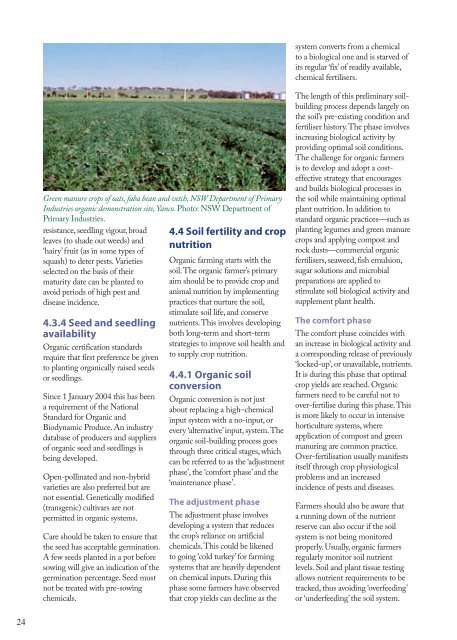4. Organic vegetable production
4. Organic vegetable production
4. Organic vegetable production
Create successful ePaper yourself
Turn your PDF publications into a flip-book with our unique Google optimized e-Paper software.
system converts from a chemical<br />
to a biological one and is starved of<br />
its regular ‘fix’ of readily available,<br />
chemical fertilisers.<br />
Green manure crops of oats, faba bean and vetch, NSW Department of Primary<br />
Industries organic demonstration site, Yanco. Photo: NSW Department of<br />
Primary Industries.<br />
resistance, seedling vigour, broad<br />
leaves (to shade out weeds) and<br />
‘hairy’ fruit (as in some types of<br />
squash) to deter pests. Varieties<br />
selected on the basis of their<br />
maturity date can be planted to<br />
avoid periods of high pest and<br />
disease incidence.<br />
<strong>4.</strong>3.4 Seed and seedling<br />
availability<br />
<strong>Organic</strong> certification standards<br />
require that first preference be given<br />
to planting organically raised seeds<br />
or seedlings.<br />
Since 1 January 2004 this has been<br />
a requirement of the National<br />
Standard for <strong>Organic</strong> and<br />
Biodynamic Produce. An industry<br />
database of producers and suppliers<br />
of organic seed and seedlings is<br />
being developed.<br />
Open-pollinated and non-hybrid<br />
varieties are also preferred but are<br />
not essential. Genetically modified<br />
(transgenic) cultivars are not<br />
permitted in organic systems.<br />
Care should be taken to ensure that<br />
the seed has acceptable germination.<br />
A few seeds planted in a pot before<br />
sowing will give an indication of the<br />
germination percentage. Seed must<br />
not be treated with pre-sowing<br />
chemicals.<br />
<strong>4.</strong>4 Soil fertility and crop<br />
nutrition<br />
<strong>Organic</strong> farming starts with the<br />
soil. The organic farmer’s primary<br />
aim should be to provide crop and<br />
animal nutrition by implementing<br />
practices that nurture the soil,<br />
stimulate soil life, and conserve<br />
nutrients. This involves developing<br />
both long-term and short-term<br />
strategies to improve soil health and<br />
to supply crop nutrition.<br />
<strong>4.</strong><strong>4.</strong>1 <strong>Organic</strong> soil<br />
conversion<br />
<strong>Organic</strong> conversion is not just<br />
about replacing a high–chemical<br />
input system with a no-input, or<br />
every ‘alternative’ input, system. The<br />
organic soil-building process goes<br />
through three critical stages, which<br />
can be referred to as the ‘adjustment<br />
phase’, the ‘comfort phase’ and the<br />
‘maintenance phase’.<br />
The adjustment phase<br />
The adjustment phase involves<br />
developing a system that reduces<br />
the crop’s reliance on artificial<br />
chemicals. This could be likened<br />
to going ‘cold turkey’ for farming<br />
systems that are heavily dependent<br />
on chemical inputs. During this<br />
phase some farmers have observed<br />
that crop yields can decline as the<br />
The length of this preliminary soilbuilding<br />
process depends largely on<br />
the soil’s pre-existing condition and<br />
fertiliser history. The phase involves<br />
increasing biological activity by<br />
providing optimal soil conditions.<br />
The challenge for organic farmers<br />
is to develop and adopt a costeffective<br />
strategy that encourages<br />
and builds biological processes in<br />
the soil while maintaining optimal<br />
plant nutrition. In addition to<br />
standard organic practices—such as<br />
planting legumes and green manure<br />
crops and applying compost and<br />
rock dusts—commercial organic<br />
fertilisers, seaweed, fish emulsion,<br />
sugar solutions and microbial<br />
preparations are applied to<br />
stimulate soil biological activity and<br />
supplement plant health.<br />
The comfort phase<br />
The comfort phase coincides with<br />
an increase in biological activity and<br />
a corresponding release of previously<br />
‘locked-up’, or unavailable, nutrients.<br />
It is during this phase that optimal<br />
crop yields are reached. <strong>Organic</strong><br />
farmers need to be careful not to<br />
over-fertilise during this phase. This<br />
is more likely to occur in intensive<br />
horticulture systems, where<br />
application of compost and green<br />
manuring are common practice.<br />
Over-fertilisation usually manifests<br />
itself through crop physiological<br />
problems and an increased<br />
incidence of pests and diseases.<br />
Farmers should also be aware that<br />
a running down of the nutrient<br />
reserve can also occur if the soil<br />
system is not being monitored<br />
properly. Usually, organic farmers<br />
regularly monitor soil nutrient<br />
levels. Soil and plant tissue testing<br />
allows nutrient requirements to be<br />
tracked, thus avoiding ‘overfeeding’<br />
or ‘underfeeding’ the soil system.<br />
24

















